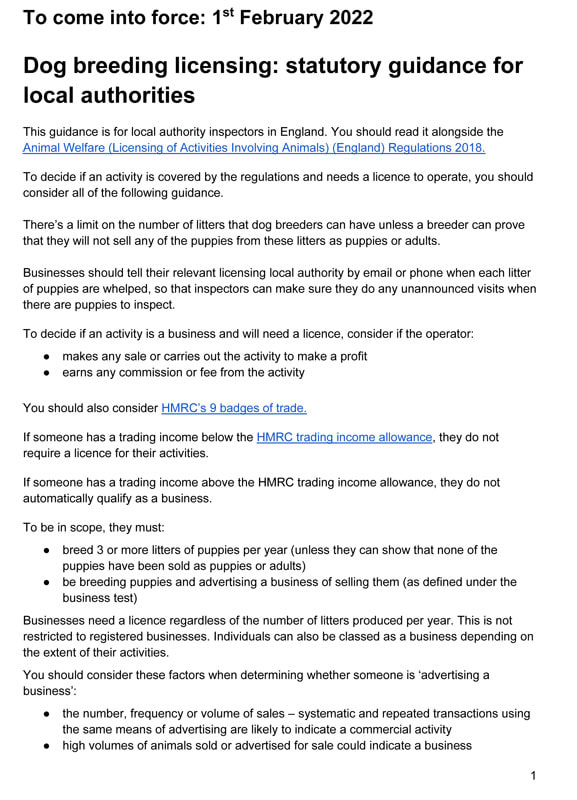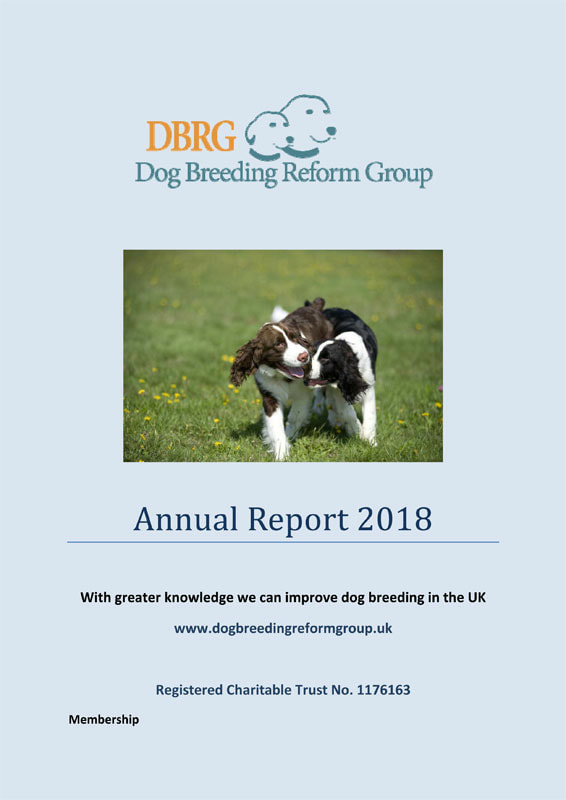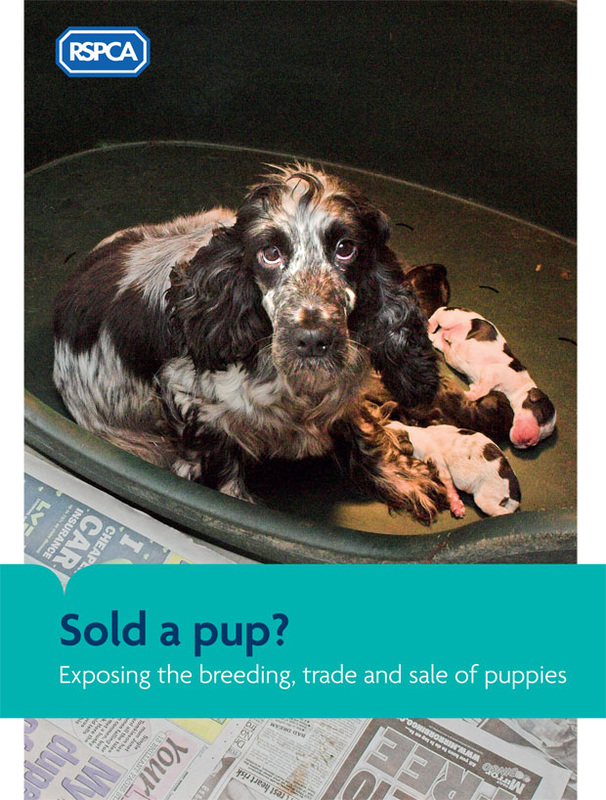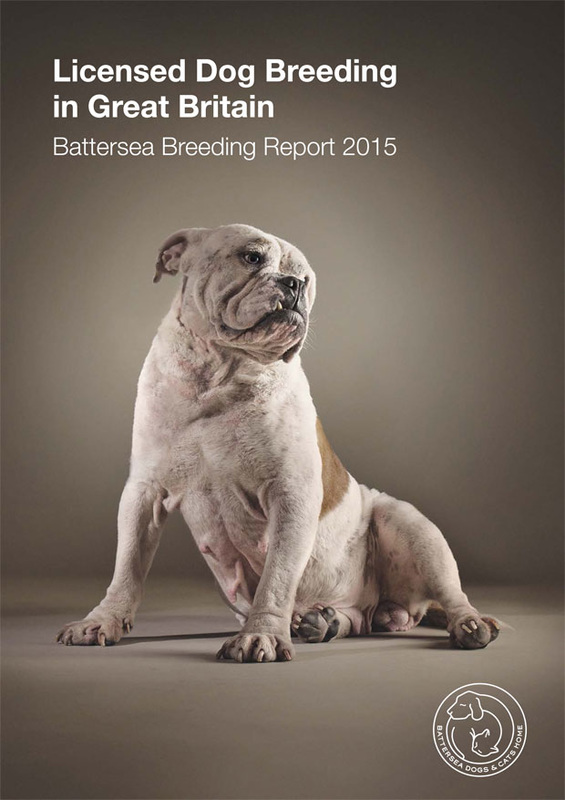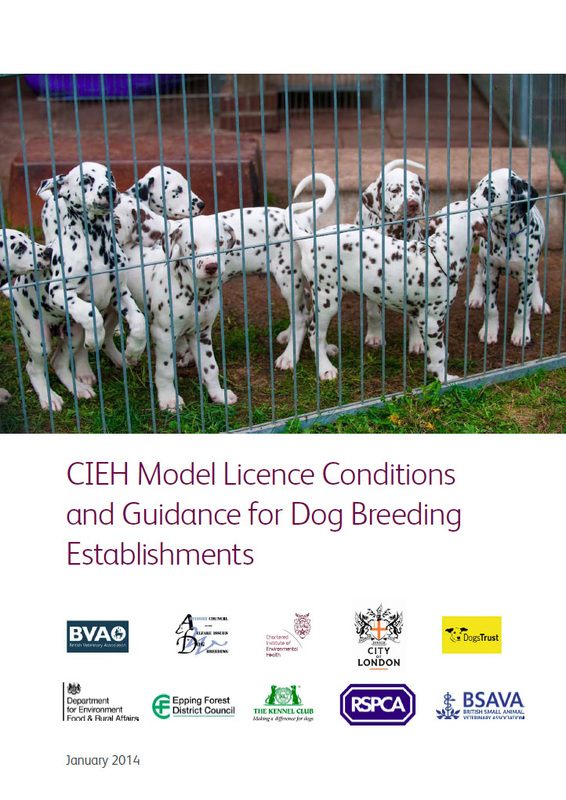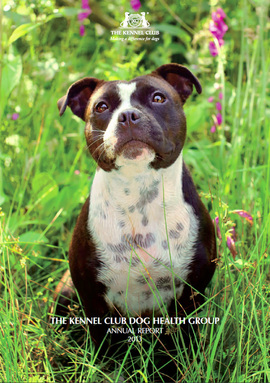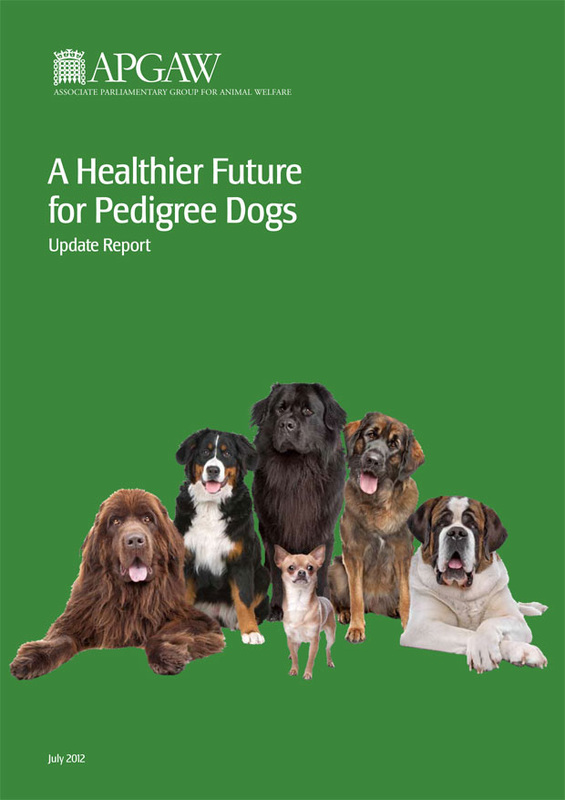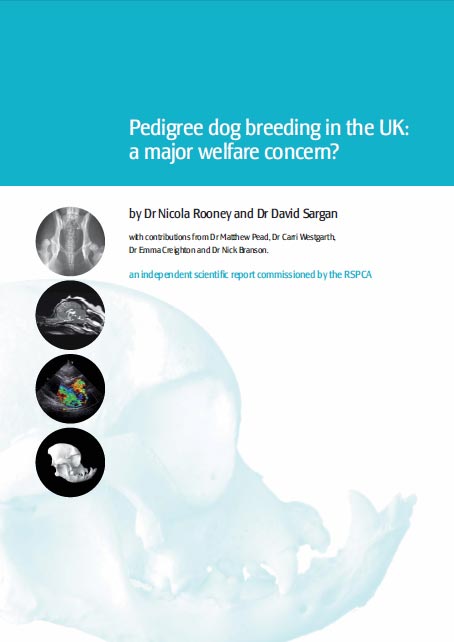Welfare Reports: Introduction
|
The publication of the Companion Animal Welfare Council's (CAWC) Report 'Breeding and Welfare in Companion Animals' in 2006 brought to light the harmful consequences of breeding dogs in closed gene pools in pursuit of arbitrary standards of appearance. This was done in order to satisfy human aesthetic preferences rather than improving the health and welfare of dogs. Huge public concern was created when the BBC documentary film, 'Pedigree Dogs Exposed' was aired in 2008. The film revealed graphically the poor state of health of many of our popular dog breeds. Not only did it depict the suffering of the dogs but the emotional and financial cost to owners too, many of whom had obtained their dogs in good faith from a 'reputable breeder.' Many Reports concerning dog health and welfare have been published since 2008 and these are available below. |
Dogs are sentient beings. They can feel fear, discomfort, pain and loneliness. Dogs are entirely dependent on humans for their health, happiness and quality of life. We know how much joy, fun and companionship a dog can give to its human family. This knowledge should be enough to ensure that society protects its canine population. |
The Welfare Reports
- Most recent at top -
Environment, Food and Rural Affairs Committee
Pet welfare and abuse - Report March 2024
|
Eurogroup for Animals
Extreme breeding in Europe - Mapping of legislation
|
The Kennel Club
Play Your Part: Breeding, Buying and Bringing Up Bracephalic Dogs Better
|
DBRG
Dog breeding licensing: statutory guidance for local authorities
|
Naturewatch Foundation Animal Welfare
Breeding Beyond Dogs' Limits - Canine Fertility Clinics in the UK
Canine Fertility Clinics are the latest UK dog breeding phenomenon. The number of businesses selling breeding procedures and related services for people who breed dogs has increased rapidly in recent years. Some of these are entirely unregulated and unaccountable. The Report examines the canine fertility sector in the UK and outlines findings from Naturewatch Foundation's survey for veterinary professionals. It also suggests a way forward so that we can begin to tackle the challenges posed in this new sector. Its recommendations include: a public statement from the RCVS; a Defra Task Force; strengthened breeding recommendations; reform of the Veterinary Surgeons Act 1966; collaboration between dog welfare organisations on initiatives to improve the welfare of dogs used for breeding and their offspring.
|
APGAW (All Party Group for Animal Welfare)Improving the Effectiveness of Animal Welfare Enforcement July 2022
The Report highlights the lack of consistency of enforcement of Animal Welfare Law and summarises the key issues. It recommends that local authorities should have access to Dedicated Animal Welfare Officers to enforce Animal Welfare law, including the Animal Welfare (Licensing of Activities Involving Animals) England Regulations 2018. Training would be a requirement for the Animal Welfare Officers. Also the setting up of regional Animal Welfare Forums which include local authority Animal Welfare Officers, the RSPCA and Police. The establishment of a National Animal Welfare Board consisting of representatives from each regional Animal Welfare Forum, RSPCA, Police, DEFRA and relevant NGOs.
|
The UK Pet Industry - Pets4Homes
The Slow Return to a New 'Normal'
The Report looks at the affects of the Covid lockdown on pet purchasing (dogs in particular) and the return to a more normal pattern. Market trends during the pandemic showed that pet ownership increased steeply, and supply struggled to meet demand, pushing prices up dramatically. Post lockdown there is a return to pre-pandemic demand for pets and some decreases in prices. The Golden Retriever was the most sought after breed. The research showed that buyer vigilance needs to improve. The rise in breeding by 'hobby breeders' is concerning as these breeders are unregulated.
|
The Scottish Government
The Animal Welfare (Scotland) Regulations 2021
The Guidance on Licensed Dog Breeding echoes much of the English Regulations and Guidance and includes the Condition: No dog may be kept for breeding if it can reasonably be expected, on the basis of its genotype, conformation, behaviour or state of health, that breeding from it could have a detrimental effect on its health or welfare or the health and welfare of its offspring. It states that licence holders must be aware of breed specific health risks and that appropriate health screening relevant to the breed should be carried out.
The Guidance specifically recommends caution in regard to the Kennel Club's category 3 breeds, ie those breeds identified as having extreme physical features which predispose them to health and welfare problems. |
IPFD - Annual Report 2020A Year Like No Other
The International Partnership for Dogs (IPFD) facilitates the collaboration and sharing of resources to enhance the health, well-being and welfare of pedigree dogs and all dogs worldwide. Its goal is to facilitate the sharing of knowledge across all stakeholders worldwide. It has initiated specific actions to improve dog health and well-being, such as supporting globally relevant breed-specific breeding strategies. A major development has been the project, Harmonisation of Genetic Testing for Dogs (HGTD), which is regularly updated and provides a breed relevance rating (BRR). The next International Dog Health Workshop (DHW) will be in 2022.
|
European Commission - Welfare in Pet TradeResponsible Dog Breeding Guidelines 2020
The EU Responsible Dog Breeding Guidelines 2020 reminds us of the close bond, understanding and communication between dogs and humans. The Report reminds us that poor breeding practices have profoundly detrimental effects on dog welfare and on the well-being of owners. Poor breeding may lead to a lifetime of suffering, through poor health and poor suitability as pets, resulting in an untimely death, abandonment or relinquishment. Dogs and puppies have the same need for a good quality of life regardless of breeding context and all breeders are required to act responsibly and with compassion to meet those needs.
The Guidelines are intended to support enforcement of responsible breeding and good animal welfare practices by competent authorities. The criteria for good practice are set out in these guidelines. |
EU Dog & Cat AllianceThe welfare of dogs and cats involved in commercial practices 2020
This report describes the legislation in place across the EU for the protection of dogs and cats. It confirms the wide variation across countries and highlights substantial gaps in the national legislation in protecting dogs and cats used in breeding and selling. The report recommends compulsory permanent identification on a appropriate database linked to an EU database; compulsory licensing of cat and dog breeders and harmonised EU standards for breeders; a ban on third party sales of dogs and cats; appropriate controls on internet sales; specific requirements for the transport of dogs and cats in the context of economic activity; controls on the internet trade of cats and dogs; a ban on surgical mutilations. Fifteen out of 28 member states have legislation to prevent the selective breeding of dogs and cats with genetic problems such as inherited disease or exaggerated conformations.
This is an update of an earlier report in 2015 |
Finnish Food Authority Finnish Government Report: Improving the implementation of animal welfare legislation in animal breeding 2020
Part 2: Preliminary analysis of problems and means of intervention in the breeding of dogs
The Report focuses on the hereditary characteristics of significant welfare factors that require the urgent implementation of the Animal Welfare Act. It focuses on the health of brachycephalic (short-skulled) dogs and concludes that if the welfare problems caused by exaggerated features are tackled solely by means of health examinations without changing the physical characteristics themselves those welfare problems will persist. It concludes that lasting results can only be achieved by changing those characteristics. |
Dog Breeding Reform Group and CFSG
Code of Practice for Dog Breeding 2020
The Code of Practice for Dog Breeding sets the standard for care and management of breeding dogs and their offspring. It applies to all dogs used for breeding (both male and female) and all the puppies produced, regardless of whether a breeder is licensed or not.
It is particularly relevant in the light of the current 'pandemic puppy' welfare emergency where inexperienced dog owners are cashing in on the demand for puppies and charging extremely high prices for them. |
DEFRA
The Animal Welfare (Licensing of Activities Involving Animals) (England) Regulations 2018 - Guidance notes for conditions for breeding dogs - Updated April 2020
The Guidance notes outlines the conditions that must be complied with in order to obtain an animal activities licence for the activity of breeding dogs. Such businesses are awarded a licence on the basis of a risked-base, star rated system and must comply with the 2006 Animal Welfare Act. Dog breeding businesses are encouraged to achieve a higher rating.
Schedule 6 includes: No dog may be kept for breeding if it can reasonably be expected, on the basis of its genotype, phenotype or state of health that breeding from it could have a detrimental effect on its health or welfare or the health and welfare of its offspring |
DBRGThe Standard for Dog Breeding 2017
This detailed Standard for Dog Breeding was adapted from an original Standard written by the Advisory Council on the Welfare Issues of Dog Breeding. When the Advisory Council's term came to an end in 2014 the Standard was updated and became the DBRG Standard and Guidance for Dog Breeding.
The Standard has been superceded by the 2018 Government Guidelines on Dog Breeding and in 2020 by the Code of Practice for Dog Breeding. The Standard for Dog Breeding remains a practical, relevant and detailed document for those who wish to breed dogs according to the highest ethical criteria. |
Wales Animal Health and Welfare Framework Group (WAHWFG) Report of Recommendations to the Welsh GovernmentReview of the Animal Welfare (Breeding of Dogs) (Wales) Regulations 2014 December 2019
In the Report the WAHWFG finds that the current Regulations for Dog Breeding in Wales are inadequate. The key recommendations include improved training for local authority inspectors of breeding establishments to enable more effective enforcement or regulations; a Registration system for all dog breeders; improved traceability of dogs through a national microchip database; an improved ratio in dog breeding establishments of one human to 10 adult dogs; a ban on the third party sale of dogs.
|
CFSGCFSG Guidance on Dog Conformation
The CFSG Guidance on Dog Conformation is intended to educate, inform and improve public awareness about dog conformation and its impact on dogs and wider society. It supports the Regulations relating to breeding and provides practical guidance for anyone breeding, selling or buying a dog whether for the purpose of further breeding or as a family pet. It highlights some of the key conformational aspects to look for in a dog when making decisions decisions on whether to breed from or acquire a dog.
If intending to breed from a dog, the Guidance can be used in conjunction with the legislation and related guidance to determine whether or not to breed from either potential parent. It should also be used in conjunction with the Code of Practice for Dog Breeding. |
Scottish SPCAAssured Puppy Breeders Scheme Welcome Pack
The Scottish SPCA Assured Breeders Scheme is intended to ensure that members of the public buy puppies from reputable breeders and don't fall into the trap of buying from a puppy farmer or illegal puppy dealer.
The Scheme endorses good, ethical breeders who breed to the highest health and welfare standards.. The Welcome Pack includes information for both breeders and buyers, including a Puppy Contract. The Welcome Pack also includes appropriate health screening to ensure dogs are of good physical, mental and genetic health. |
DEFRA
Ban of commercial third party sales of puppies and kittens in England: Summary of responses and way forward December 2018
This Report is based on a Defra consultation for the banning of the sale of puppies and kittens by anyone other than the person who has bred them. The consultation is based on the concern that commercial third party sales lead to poorer welfare conditions for the animals compared to when people buy direct from the breeder.
Earlier separation of puppies from their mothers can lead to a lack of socialisation and habituation for puppies and an increased risk of disease. This method of sales is also likely to mean that genetic health screening on parent dogs has not been carried out by the breeder. |
Dog Breeding Reform GroupAnnual Report 2018
This is our second Annual Report since becoming a registered charitable trust. The Report summarises our activities during 2018. These include the uploading of advice to puppy buyers and information about the BVA Canine Health Schemes on to the DBRG website. Through our consultation responses, DBRG has helped to bring about new regulations for dog breeding and a promise from the Government to ban the third party sale of puppies. DBRG's work was recognised at the CEVA Animal Welfare Awards (Charity Team of the Year) and by being invited to be a collaborative partner of the International Partnership for Dogs (IPFD). We also became an Associate Member of the Canine and Feline Sector Group. We launched our Student Ambassador Scheme.
|
British Veterinary Association (BVA)
Pets in Advertising - A social concern
The BVA Report (November 2018) provides guidance for good practice in
the use of animals in advertising. The Report is based on the five animals welfare needs described in the Animal Welfare Act 2006 and recommends that all animal imagery in advertising depicts pets in situations that meet their welfare needs. These needs are:
|
DEFRAThe Animal Welfare (Licensing of Activities Involving Animals) (England) Regulations 2018
Guidance notes for conditions for breeding dogs These are the detailed Guidelines that accompany the new Regulations and are aimed at local authority inspectors in England . The Guidelines should be read in conjunction with the Regulations.
In order to gain a licence for Dog Breeding a business will need to meet all of the minimum standards outlined in this document. In addition, businesses are encouraged to apply higher standards in order to achieve a 4 or 5 Star rating. Of particular significance for the higher rating is the requirement for a record of lineage, including coefficient of inbreeding (COI), health testing for hereditary diseases and use of a Puppy Contract. The Guidance Notes are a welcome development towards better welfare standards in Dog Breeding. The use of a star rated system of licensing will hopefully encourage more breeders to adopt even higher welfare standards. DBRG's view is that all dogs used for breeding and their offspring deserve the very highest standards of care. These Guidance Notes are an important step towards that goal. |
The Animal Welfare (Licensing of Activities Involving Animals) (England) Regulations 2018
This is the long awaited Regulations on the Licensing of Activities Involving Animals.
The Regulations bring many more dog breeders under the local authorities licensing regime. Anyone who breeds three or more litters of puppies per year must be regularly inspected and obtain a licence from their local authority. Schedule 6 provides Specific Conditions for the Breeding of Dogs. The Regulations stipulate that no puppy under the age of eight weeks may be sold and a puppy may only be sold if it is together with its biological mother. Puppies must be socialised and habituated to their future life as a pet. Female dogs used for breeding may only have one litter in a six month period and no more than 6 litters in total. Each puppy must be microchipped and registered to the breeder before it is sold. And crucially: 'No dog may be kept for breeding if it can reasonably be expected, on the basis of its genotype and phenotype or state of health that breeding from it could have a detrimental effect on its health or welfare of that of its offspring.' |
Dog Breeding Reform Group
The Animal Welfare Act and the Protection of Offspring
This Report suggests ways in which the Offspring of Dogs could be better protected under the existing Animal Welfare Act (2006) from inherited diseases and health and welfare problems due to extreme conformation. The Animal Welfare (Licensing of Activities Involving Animals) Regulations 2018 states that 'No dog may be kept for breeding if it can reasonably be expected, on the basis of its genotype, phenotype or state of health that breeding from it could have a detrimental effect on its health or welfare or that of its offspring.' In principle, therefore, such protection is enshrined in law. In practice, however, this condition will be difficult to enforce. This report makes recommendations as to how, in practice, this principle may be more easily enforced.
|
DEFRA
Code of practice for the welfare of dogs
The revised Code of Practice for the Welfare of Dogs was published in 2017. The Code is based on the Animal Welfare Act 2006 and outlines the five welfare needs for a dog and an owner's responsibility to fulfil those needs. These include: (a) need for a suitable environment (b) need for a suitable diet (c) any need a dog has to be to be kept with or apart from other animals (d) need to be able to exhibit normal behaviour (e) need to be protected from pain, injury, suffering and disease. The appropriate agents, such as local authorities, the police, or RSPCA may prosecute a person who does not provide these basic welfare needs for a dog.
|
The Kennel Club
Breed Health Improvement Strategy:
A step-by-step guide This Report aims to help Breed Clubs and Breed Health Co-ordinators embark on a process designed to improve the overall health of their breed. Attention is paid to identifying the specific health problems of the breed and addressing in-breeding and genetic diversity.
|
PDSA Animal WellbeingPAW Report (2018)
This Report looks primarily at the state of well-being of the nations pets. It is structured around owners' knowledge and application of the Animal Welfare Acts 2006 and the five Welfare Needs that are enshrined within them. It highlights the areas of well-being that still require improvement.. For dogs this includes obesity and insufficient exercise, The Report also finds that 24% of dogs are left alone for more than 5 hours a day and 24% of owners did not see the puppy with its mother.
|
The RSPCA
Being #DogKind:
How in tune are we with the needs of our canine companions? In this Report the RSPCA publishes its research on dog ownership in the UK. There are an estimated 11.5 million dogs in the UK and a quarter of all households share their homes with a dog. The Report asks how much do owners understand about the needs of their dog to ensure that they are physically fit and psychologically fulfilled. Some of the Reports findings are that 22% of dogs spend four hours or more alone each working day. Nearly half of all dogs get between 30 and 60 minutes exercise every day but 20% of dogs are never let off the lead. Most owners agree that dogs need regular opportunities to play. Only 39% of owners attend training classes.
|
Dog Breeding Reform Group
Annual Report 2017
This is DBRG's the first Annual Report in which an outline of its activities during 2017 are outlined. It precedes the official registration with the Charity Commission as a registered charitable trust (No. 1176163). Highlights include the first DBRG Symposium in collaboration with the University of Surrey Vet School in October and attendance at the international Dog Health Workshop in Paris in April. Several position papers were completed as well as written submissions to key Government consultations associated with animal welfare.
|
Government Response to the EFRA Committee Report: Animal Welfare in England
Domestic Pets
The Government responds to each of the recommendations of the Environment, Food and Rural Affairs Committee Report: Animal Welfare in England: domestic pets.
New regulations will be in place in 2018 for animal activities licensing. Regarding the progeny of dogs the Government cites the Kennel Club's Assured Breeders' Scheme which requires the genetic screening of dogs to reduce the risk from inherited conditions. (In the view of DBRG these are minimal). 'We will explore the possibility of further protecting the progeny of dogs within the proposals to modernise the dog breeding regulations. The Government rejects Efra's proposals to ban the third party sale of puppies on the grounds that sales would be driven underground. |
DEFRA Review of Animal Establishments Licensing in England
Next Steps
Following a consultation process, Defra published its Report outlining the Next Steps in the Review of Animal Establishments Licensing. The intentions are to create new Model License Conditions for Dog Breeding which will become law. No puppies may be sold under eight weeks; the statutory licensing threshold will be three or more litters; each breeding bitch should have no more than one litter a year; there will be a requirement for licensed breeders to display their local authority licence number when advertising; local authorities will be required to use a risk-based system, including a consideration of an affiliation to a body accredited by UKAS, such as the Kennel Club Assured Breeders Scheme (ABS)
|
Blue Cross
Unpicking the Knots:
The case for a more cohesive approach to pet welfare legislation This Report paints a picture of the current state of statutory enforcement of pet legislation in Britain. Local authorities are responsible for running a licensing system for dog breeding establishments. However, a lack of personnel and appropriate training, together with slashed budgets, has left many of them without the resources and confidence to deal with animal welfare legislation suitably and effectively. There are issues around consistency and clarity of duties and resource levels mean that the majority of local authorities only have the capacity to deal with licensed premises. The scale of the unlicensed and invisible trade makes this a serious welfare concern.
|
PDSA Animal Wellbeing
PAW Report (2016)
The PDSA PAW Report 2016 includes other companion animals as well as dogs. It includes research findings about how dog owners go about choosing a dog and searching for a breeder. It includes the estimated cost of dog ownership throughout its lifetime and insights into behaviour and training. The problem of dogs being left alone for several hours at a time is identified as a significant welfare problem. as well as obesity in dogs. Awareness by dog owners of the Animal Welfare Act 2006 and the '5 needs' is shockingly low (35%). The Report finds that choice of breed or type of dog is based on temperament (45%), previous experience with the breed (27%), size (26%), how the dog looks (22%). Choosing a breed for its health was stated as a reason by 6% of owners.
|
Environment, Food & Rural Affairs Committee
Animal welfare in England: domestic pets
Third Report of Session 2016-17 This important Report recommends that the Government pass regulations to protect the genetic viability and welfare of offspring as well as adult dogs. It recommends that anyone breeding two litters or more per year should be licensed and a national inspectorate should be established to support local authorities in enforcement. The third party selling of dogs should be banned and the age at which dogs can enter the UK should be increased to six months. The Pet Advertising Advisory Group (PAAG) minimum standards should be mandatory for all websites where pets are advertised for sale and that all internet ads should include the registration or licence number of the seller. A statutory duty should be placed on local authorities to enforce the Animal Welfare Act and appropriate resources made available. The maximum penalty for animal welfare offences should be increased to five years imprisonment.
|
The RSPCA
Sold a pup? (2016)
RSPCA 'Sold a pup? published in 2016 investigates the sources of puppies needed to supply the home market demand which cannot be met by UK produced pups. Poor health and welfare standards already exist in some UK commercial breeding establishments and it can be even worse in some breeding establishments in Ireland and continental Europe. The Report publishes annual figures: unlicensed breeders in the UK (excluding Kennel Club registered puppies) produce 400,000; licensed breeders in the UK produce 70,000; Kennel Cub registered puppies 235,000; rescue organisations in the UK 3,000; imported from the Continent 30,000; imported from Ireland 30,000- 40,000.
|
The Coalition
|
Canine Action UK
Licensed Third Party Puppy Vending in Great Britain (2016)
Julia Carr's Report identifies all premises selling puppies which hold a pet shop licence. It presents the scale of the licensed third party puppy trade in the UK and examines the inspection processes and supply chain. Three types of third party selling of puppies are identifed: retail premises (38%); dealers selling from non-retail premises (38%); hybrid sellers (licensed breeders selling bought-in puppies alongside those bred on site) (41%). As many as 80,000 puppies are sold in this way per year and it is a growing welfare issue. The licensing process was found to be ineffective. The Report concludes that a reformed system is needed which incentivises the highest welfare standards to ensure that puppies bred are fit for life as family companions. Selling puppies through licensed pet shops cannot meet this objective.
|
The Kennel Club Dog Health Group
Annual Report (2015)
The Dog Health Group develops strategy on the health and welfare aspects of the KC’s work. It highlights the Pedigree Breed Health Survey and promises breed specific reports in March 2016. It declares its commitment to tackling CMSM and calls for the use by breeders of the BVA/KC CMSM health scheme in order to collect ‘robust data.’ The KC is a member of the International Partnership for Dogs (IPFD) to collaborate with other kennels clubs on health matters. The DHG sub-groups include: assured breeder scheme; breed standards and conformation; genetics and health screening.
|
Battersea Dogs & Cat Home
Licensed Dog Breeding in Great Britain (2015)
This report, published in October 2015, examines the scale of licensed dog breeding operations in the UK. It finds that 88% of puppies are produced by unlicensed breeders and recommends lowering the licensing threshold to two litters. It finds a huge variety in licence fees across the UK and concludes that dog licensing is in need of a complete overhaul.
|
EU Dog and Cat Alliance
The welfare of dogs and cats involved in commercial practices: a review of the legislation across EU countries (2015)
This report describes the legislation in place across the EU for the protection of dogs and cats. It confirms the wide variation across countries and highlights substantial gaps in the national legislation in protecting dogs and cats used in breeding and selling. The report recommends compulsory permanent identification on a appropriate database linked to an EU database; compulsory licensing of cat and dog breeders and harmonised EU standards for breeders; a ban on third party sales of dogs and cats; appropriate controls on internet sales; specific requirements for the transport of dogs and cats in the context of economic activity. Fifteen out of 28 member states have legislation to prevent the selective breeding of dogs and cats with genetic problems such as inherited disease or exaggerated conformations.
A summary of the regulations regarding breeding and inherited diseases or exaggerated conformations is contained in a separate document and may be viewed here. |
The Kennel Club Dog Health Group
Annual Report (2014)
In this Report the Health Group announces that having made significant progress on health and welfare issues, the Clumber Spaniel has been removed from category 3.
The Assured Breeders Scheme (ABS) membership as of January 2015 is 6,690 ( a drop of 1,694) This is due to the increase in fees from £10 to £30 and tighter rules regarding inspection visits. Figures for the BVA/KC CMSM Scheme are disappointing, particularly for Cavalier King Charles Spaniels – the worst affected breed. Only 145 dogs have been tested. No comment is made in the Report, but it is well known that Cavalier breeders are unwilling to pay for the cost of testing. It remains to be seen whether Cavalier breeders will take up the Kennel Clubs offer of funding the resubmission of old MRI scans. |
The Advisory Council
Advisory Council on the Welfare Issues of Dog Breeding (2014)
The Final Report of the Advisory Council on the Welfare Issues of Dog Breeding sets out the Council’s achievements and recommendations for further action. The Council’s Breeding Standard is a model for all dog breeding whether KC registered pedigree dogs, other purebred dogs, or mixed breeds. Recommendations are made for tackling the priority breed related genetic conditions, such as cancer, skin disease, neurological diseases and autoimmune diseases. The Council’s Recommendations for the Regulation of Dog Breeding include, the repeal of outdated legislation and replacement by statutory Codes of Practice under the 2006 Animal Welfare Act. The Council’s Standard for Breeding Dogs should become a statutory Code. It also includes, a requirement for all dog breeders to be registered with a local authority and for breeders of two or more litters a year to be local authority licensed. A working group chaired by Dr David Sargan will be set up to make recommendations regarding the welfare impact of exaggerated breed conformations.
|
All-Party Parliamentary Group for Animal Welfare Sub-Group for Dogs
Review and Recommendations for Developing an Effective England-wide Strategy for Dogs (2014)
This Report covers the areas of Dog Control, Dog breeding, dealing and trading, Dog identification, and Responsible dog ownership. Regarding dog breeding, the report recommends that the current laws need to be reviewed and updated. This should be done via Regulations and statutory Codes of Practice under the Animal Welfare Act 2006. It also recommends a more consistent approach to licensing and enforcement by local authorities. It recommends a Standard for Breeding (such as the KC’s Assured Breeders Scheme Standard, or the Dog Advisory Council’s Breeding Standard) that could form part of self regulation. It recommends that the Puppy Contract (BVA AWF/RSPCA) should be endorsed and promoted by Defra.
|
Centre for Animals and Social Justice (CASJ)
Animal Protection Commission - A Policy Proposal 2014
This Report and Policy Proposal makes the point that currently there is no government body with responsibility for animal welfare matters. DEFRA is the Government Department with overall responsibility for matters relating to animals but it is not explicitly tasked with protecting or improving animal welfare. Decision making is dominated by ‘historically entrenched domination by industry representatives and interests.’ This report proposes major institutional reform to establish animal welfare as a goal of Government policy in order to give it ethical and democratic legitimacy. The report advocates the creation of an Animal Protection Commission (APC) which would assume regulatory and advisory responsibility for all animal welfare-related matters.
|
The Kennel Club
A Dog’s Life Manifesto (Autumn 2014)
This report was published by the UK Kennel Club ahead of the 2015 general election ‘to guide the next government’ on dog related matters. In its introduction, the Kennel Club’s Chairman, Steve Dean, claims that it is the ‘UK’s largest organisation dedicated to improving the welfare, health and general wellbeing of dogs.’ The section on Breeding calls upon the next government to introduce measures to improve breeding practices to ensure that dogs’ health and welfare are prioritised. The Report recommends that the KC’s own Assured Breeders Scheme should be made mandatory. It also recommends that in order to reduce the burden on local authorities the KC should be involved in the inspection of licensed breeding premises.
|
Stephen Wooler CB
The Independent Review of the Prosecution Activity of the RSPCA (Wooler Report) (September 2014)
The Wooler Report acknowledges the lack of structure and cohesiveness in the overall arrangements for the enforcement of animal welfare legislation. It recognises the 21st century anomaly that there is no public body within central and local government that has overall responsibility for the enforcement of animal welfare law. It is largely left to the RSPCA, a private charity funded by public donations, to investigate and enforce animal welfare law. The Report recommends that the RSPCA should work more closely with government and public sector counterparts and to maintain public confidence by providing accountability and transparency.
|
The Chartered Institute of Environmental Health
CIEH Model Licence Conditions and Guidance for Dog Breeding Establishments (England) (Jan 2014)
The Chartered Institute of Environmental Health (CIEH), Dog Advisory Council, British Veterinary Association and other organisations produced this guidance for local authorities and their authorised officers and veterinary inspectors for the inspection of dog breeding establishments. In 2012, at the request of the Department for the Environment, Food and Rural Affairs (DEFRA) the working group came together to update Guidance for inspectors to include the provisions that must be taken into account under the Animal Welfare Act 2006. It is expected that all local authorities will use this Guidance so that inspection procedures will be consistent throughout the country.
|
The Kennel Club Dog Health Group (DHG)
Annual Report (2013)
The achievements of the DHG are outlined in this report, including the sum of £536,205 donated by the KC’s Charitable Trust for the study of canine health. It announced the establishment of the open access on line journal on canine genetics and epidemiology. It features the efforts of the French Bulldog Club to improve the health of the breed and its removal from the list of high profile breeds. It also features improvements in the Assured Breeders Scheme and changes to the Breed Watch programme (high profile breeds now known as category 3). Progress has also been made in health screening and providing an increased number of DNA tests.
|
Environment, Food & Rural Affairs Committee
Report on DOG CONTROL AND WELFARE (February 2013)
Section 3 of this Report deals with the Breeding and Welfare of Dogs and makes some welcome recommendations. These are that anyone breeding more than two litters a year should be licensed by the local authority as a breeder; and that those involved in breeding dogs, including the Kennel Club and breed clubs must redouble their efforts to eradicate health problems. Health test results should be applied to breeding decisions. It also recommends outcrossing strategies for those breeds which have the most pressing health issues. It asks DEFRA to consider giving the Advisory Council on the Welfare Issues of Dog Breeding a regulatory role. It also recommends that DEFRA and welfare organisations give greater publicity to the Puppy Contract.
|
APGAWA Healthier Future for Pedigree Dogs - Update Report (2012)
This Update Report looked at the progress made so far and produced an Action Plan for the future. This included: pressure on Defra and other bodies to supply long term funding for the Dog Advisory Council; extending the Council’s powers so that it becomes an independent regulatory body; compulsory microchipping; the licensing of breeders who breed 3 litters or more a year; the KC to adopt the Advisory Council’s Breeding Standard; improved education of the general public including Animal Welfare as part of the core curriculum of schools; the Defra Code of Practice for the Welfare of Dogs to include breeding and genetic welfare issues; endorsement of the RSPCA Puppy Contract by all stakeholders.
|
Patrick Bateson
Independent Inquiry into Dog Breeding Report (2010)
This peer reviewed scientific report found that current dog breeding practices impose welfare costs on dogs ‘in many cases’ through poor husbandry, high levels of inbreeding, and the use of breeding pairs which will transmit inherited diseases to their offspring, or extreme characteristics which affect quality of life.
The report’s recommendations include: reward for breeders who deliver high welfare standards; establishing a non-statutory independent Advisory Council on Dog Breeding to develop breeding strategies on an individual breed basis; a computerised system for the collection of disease prevalence from vets; an Accredited Breeder Scheme with UKAS accreditation; permanent identification of dogs; new regulations under the Animal Welfare Act creating an obligation on dog breeders to have regard to the health and welfare of parent dogs and their offspring. |
APGAW
A Healthier Future for Pedigree Dogs (Nov 2009)
The report of the Associate Parliamentary Group for Animal Welfare inquiry into the health and welfare issues surrounding the breeding of pedigree dogs (November 2009).
This major report found ‘a serious problem with the health and welfare of many pedigree dogs’ caused by some of the current breeding practices. It suggests that action should be taken immediately to address this situation. The report’s recommendations include: a limit on the number of times a sire can be used for breeding; health screening should be made a legal requirement for dogs selected for breeding; the title of Champion should not be given unless a dog has been health screened; the word ‘pedigree’ should be linked to a high standard of breeding for health and welfare; an independent advisory body should be set up to advise the Kennel Club and breed clubs; a puppy sale contract should be introduced to protect consumers; DEFRA should take forward a campaign for public awareness. |
Dr Nicola Rooney and Dr David Sargan
Pedigree Dog Breeding in the UK:
A Major Welfare Concern? (Feb 2009) An independent scientific report commissioned by the RSPCA.
This report identified that many dogs of different breeds experience compromised welfare due to the effects of selective breeding practices. It identified two welfare issues: exaggerated anatomical features that reduce quality of life; and the increased prevalence of inherited disorders. It endorses the findings of the CAWC Report of 2006 that the welfare issues are serious and widespread. The report suggests that measures taken so far to reduce or eradicate these problems have had only limited success, due in part because most screening programs are voluntary. The report’s recommendations include: systematic collection of disease and mortality data; banning close matings; opening stud books; an ethical review of all breeds; increasing genetic diversity; making registration of dogs conditional on the health screening of parents; introducing codes of practice that prioritise health, welfare and temperament; educating the public that a desirable dog is one that experiences high welfare; the development of schemes for calculating estimated breeding values (EBVs) for genetic diseases. |
CAWC
Towards an independent advisory body on tackling genetic welfare problems in companion animals (Feb 2009)
This report acknowledged the increased level of interest in tackling genetic welfare problems particularly relating to dogs, referring to the All Party Group on Animal Welfare (APGAW), the Dogs Trust / Kennel Club independent review under Sir Patrick Bateson, and the recently published RSPCA report (Rooney and Sargan, 2009).
It was agreed that the advisory body should be independent and would need to be constituted so as to cover a spectrum of relevant sectors and interests. It would set its own priorities in the light of information about welfare problems. The scope and terms of reference of an advisory body would include all companion animals; consider the best ways forward for tackling genetic welfare problems on a breed by breed (or strain) basis; advise and promote the development of breeding strategies; make recommendations about research priorities; and communicate its findings effectively. A start will be made by engaging CAWC as the parent body for the advisory group and appointing a steering group to begin work and to look at funding. This report has been submitted to the APGAW and Bateson inquiries whose findings will in turn inform the new advisory group. |
CAWC
CAWC Approaches to Tackling Genetic Welfare Problems in Companion Animals (Oct 2008)
This report identified the lack of a structured and co-ordinated approach for addressing genetic welfare problems. It concluded that an independent advisory body be set up to consider the best way forward to tackle problems on a breed by breed basis (this may be an appropriate role for CAWC).
The authority of such a body would rest on the composition of its members and would address, with breeders and others, the ethical and practical genetic aspects. It would address the issue of whether continued breeding in a population would be justified, and if so what the aims (and perhaps methods) of the future breeding strategies should be. |
CAWC
Fixing ancestral problems. Genetics and welfare in companion animals focusing on syringomyelia in Cavalier King Charles Spaniels as an example (Apr 2008)
The aim of this workshop was to review the measures that are being undertaken to tackle genetic welfare problems, to look at the latest developments, identify bottlenecks and assess how these may be overcome. Three approaches were identified:
The report recommended that in the case of Syringomyelia scientists and breed club representatives, facilitated by the KC, should devise a scheme for collecting MRI data for use in a program to reduce or eliminate the disease. |
CAWC
Report on Breeding and Welfare in Companion Animals (2006)
This major report recognised the clear welfare consequences of selection for specific traits in companion
animals. It recognised that the welfare problems can be very serious because they can affect large numbers of animals throughout the whole of their lives and can do so generation after generation. The report also highlighted the fact that this was a welfare problem which had been largely overlooked in the past. It recommended that the following code, based on the wording of the Council of Europe Convention, 1987, be adopted by all those who breed companion animals: ‘The selection and breeding of companion animals can result in, or perpetuate, characteristics or inherited conditions that seriously affect the quality of animals’ lives. No one should breed companion animals without careful regard to characteristics (anatomical, physiological and behavioural) that may put at risk the health and welfare of the offspring or the female parent.’ |






